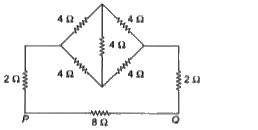Wires P and Q have the same resistance at ordinary (room) temperature. When heated, resistance of P increases and that of Q decreases. We conclude that
A
P and Q are conductor of different materials
B
P is N-type semiconductor and Q is P-type semiconductor
C
P is conductor and Q is conductor
D
P is conductor and Q is semiconductor
Video Solution
Text Solution
The correct Answer is:D
Condoctor has positive temperature coefficient of resistance but semiconductor has negative temperature coefficient of resistance.
|
Topper's Solved these Questions
- SEMICONDUCTOR ELECTRONICSBOOK - A2ZCHAPTER - SEMICONDUCTOR ELECTRONICSEXERCISE - Junction Diode
57 Videos
- SEMICONDUCTOR ELECTRONICSBOOK - A2ZCHAPTER - SEMICONDUCTOR ELECTRONICSEXERCISE - Diode In Circuits
40 Videos
- SEMICONDUCTOR ELECTRONICSBOOK - A2ZCHAPTER - SEMICONDUCTOR ELECTRONICSEXERCISE - EXERCISE
29 Videos
- NUCLEAR PHYSICSBOOK - A2ZCHAPTER - NUCLEAR PHYSICSEXERCISE - Section D - Chapter End Test
29 Videos
- SOURCE AND EFFECT OF MAGNETIC FIELDBOOK - A2ZCHAPTER - SOURCE AND EFFECT OF MAGNETIC FIELDEXERCISE - Section D - Chapter End Test
30 Videos
Similar Questions
Knowledge Check
A piece of silver and another of silicon are heated from room temperature The resistance of
Aeach of them incresesBeach of them decreasesCsilver increases and silicon decreasesDsilver decreases and silivon increasesWhat is the resistance between P and Q ?
 A34ΩB43ΩC163ΩDInfinity
A34ΩB43ΩC163ΩDInfinityWhat is the effective resistance between points P and Q?
 A5ΩB10ΩC15ΩD20Ω
A5ΩB10ΩC15ΩD20Ω
What is the effective resistance between points P and Q?

View SolutionThe resistance across P and Q in the given figure is

View SolutionThe resistance of the following circuit between P and Q is

View SolutionThe resistance of the following circuit between P and Q is

View SolutionThe temperature of germanium is decreased from room temperature to 100 K, the resistance of germanium
View Solution


